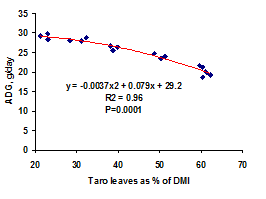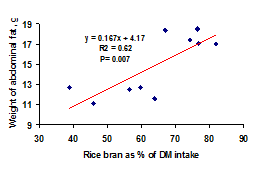
|

|
| Figure 1; Relationship between proportion of fresh taro leaves and average daily weight gain | Figure 2; Effect of the proportion of rice bran in the diet on the weight of abdominal fat |
|
MEKARN Conference 2010 |
Two on-farm experiments were conducted in a suburb of Long Xuyen City, An Giang province, Vietnam, to investigate the effect of diets of rice polishings with taro (Colocacia esculenta) foliage on the growth performance of common ducks. In experiment 1, 168 crossbred common ducks (crosses of an exotic and indigenous breed) were used in a completely randomized design (CRD) with 7 dietary treatments and 3 replicates. The ducks were offered chopped fresh taro leaves ad libitum, supplemented with five levels (3, 4, 5, 6, 7% of live weight [LW] as dry matter [DM]) of a basal diet (soybean meal, rice bran and broken rice) with a premix added There were two other treatments, the basal diet without premix fed at 3% of LW, with free-access to taro leaves, and the basal diet with premix, fed at the equivalent of 7% of LW, with no taro leaves provided. Each experimental unit included 8 ducks, balanced for sex. In experiment 2, in total 80 common ducks were used, with ten treatments, two replicates and four ducks (balanced for sex) per replicate. The dietary treatments were arranged as a 5*2 completely random factorial design, with ingredient ratio (5) and feeding system (2) as factors. The basal diet was high protein rice bran supplemented by five levels of taro silage (20, 30, 40, 50, and 60%), fed to the ducks in mixed or separate form.
In experiment 1, the total dry matter intake was highest on the treatment in which the ducks were fed 7% of LW of the basal diet supplemented by fresh taro leaves ad libitum (110g/day), and lowest in the treatment with 3% of LW of the basal diet and taro leaves ad libitum (84.4g/day). The average daily gain among treatments was significantly different (P<0.05), and was poorest in the treatment 3% of basal diet-taro leaves ad libitum. It was concluded that fresh taro leaves can meet the duck’s requirements of vitamins and minerals. In experiment 2, silage made from taro foliage (leaves and stems) was shown to replace up to 60% of the rice bran in diets for growing ducks without any reduction in growth performance and with positive effects on carcass quality (the weight of abdominal fat decreased as the taro silage intake increased).
For smallholder farmers in the Mekong delta there can be significant economic benefits from the opportunity to fatten common ducks using resources (rice bran and taro foliage) that are widely available in the region and of lower cost than commercial feeds.

|

|
| Figure 1; Relationship between proportion of fresh taro leaves and average daily weight gain | Figure 2; Effect of the proportion of rice bran in the diet on the weight of abdominal fat |